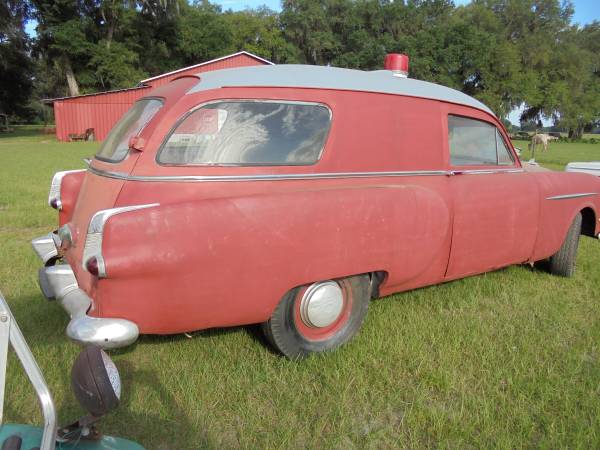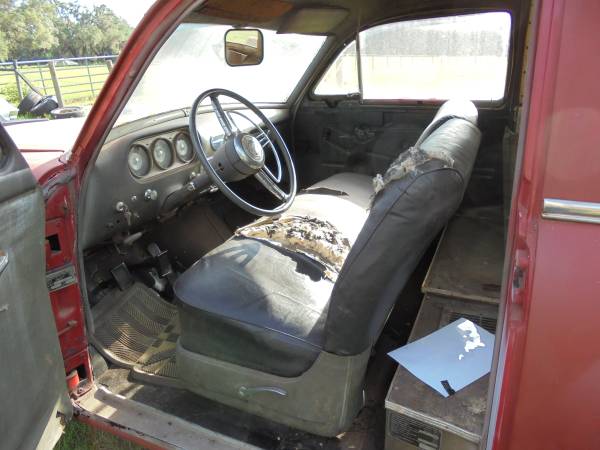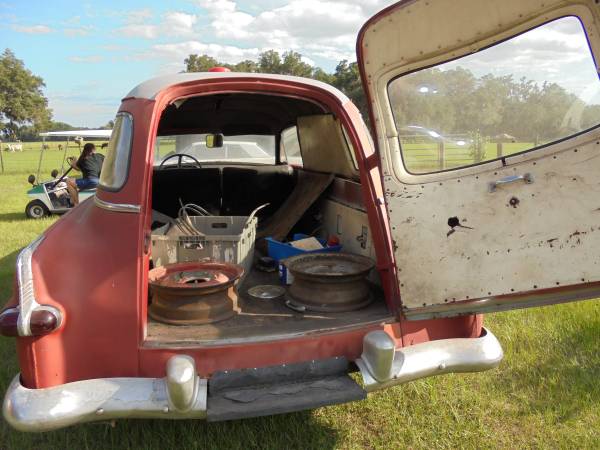In 1953 Henney decided to offer a junior model of their senior long wheel base Packard. The Juniors were very limited and were offered only for 1953-1954. A total of 500 were made. This ’53 Packard Henney Junior is in nice condition and came from an Air Force base. Being a short wheel base version certainly makes it unique, but perhaps a little easier to drive as well. Priced at just $5,500 we think this Packard would make an awesome project for some one. Find it here on craigslist out of Bushnell, Florida.
The interior isn’t half bad on this Packard, with the bench seat looking the worst of the interior, though it appears the passenger door panel is missing. The dash and steering wheel look nice. The exterior of this Packard looks nice and solid, though we are unsure of the condition of the paint that it currently wears. The chrome looks clean, and all of the trim and lights appear to be present.
The Henney Junior is cool because its shares similar looks to the Senior size that would have been a service vehicle and also more ambulance like. The Junior is likely too small to be an ambulance, but it has plenty of space to be a work hauler, and business vehicle. If we were back in time it would be a great locksmith vehicle, or a parts hauler, and would be great for other various professions.
The front end is really a masterpiece with all of the chrome of the elaborate grill. We think this Packard, could have its mechanicals restored first, and a full on restoration could come later with this one. In running shape, but not stopping shape, we think this is an awesome find with a great possibility for some useful purpose. In 1953, only 380 Henney Juniors were made, so this would also be quite the exclusive ride as well. What would you do with this 1953 Packard Henney Junior?






I often joke around and say “That’l buff out”- but I think this one actually will! A one day detailing and cleaning would go a long way.
Seller might have been wise to clean all his junk out of it first! Only one drawback to having it as a service vehicle: you’d waste half the day answering “hey, what is this?”
Yeah, but that is the cool part of driving this vehicle !
They were used as short run ambulances from the tarmac to the base hospital infirmary at smaller air bases such as Rickenbacker Air Force Base. I’ve seen “one” dressed in AF blue at Rickenbacher (no emergency lighting) with motorpool markings during my USAF career and that one was in “mothballs”. Scuttle was… it was going to the AF Museum at Wright Patterson but I have never seen it there.
Love the “look” of this.
This one has been for sale for quite a while (over a year perhaps), and come down in price from I think as high as $8k. I reeeeeeaaaalllllly want this, but am trying to get my 59 Chevy pickup into roadworthy shape to sell before I can get another project! This would be perfect for hauling my upright bass and gear to gigs when the weather is nice! I love the size too…not too big, but still pretty utilitarian!
Why, why, why, are these very cool oddball vehicles that I can afford so very far away? I’d move to be closer, but my wife wouldn’t understand, or maybe she would push me out the door and not lòok back! Um, better give this more thought.
Driningasoline is right they where used as short haul ambulances. At least it has a higher head room than some of the Cadillacs . But then those days treatment was drive faster. Disclaimer retired Firefighter Paramedic and USN 1972-1975.
Looks like he has another Packard service vehicle in the background
I’ve only seen two of these up close: one belonged to a dr. in Lubbock, TX. It had been painted solid white and had a single siren-light combination on the roof. The doc did a lot of restoration on it, and I think he sold it several years ago, at least since I left Lubbock. The other ’53 I’ve seen is extremely nice and belongs to a Professional Car Society (PCS) member. I got to see it at the PCS international meet in Lancaster, PA in 1999. There was also a ’54 Henney Packard Sr. ambulance at that meet. Both super-nice cars.
I love 50s vehicles but being of the hot rod persuasion, I’d do it over as a rod, small block, 700r4, 9″ rear. I thi,k it would get plenty if attention
Though I have never actually seen one in person. I have always been a real big fan of Packard. . Though my first challenge is getting it home. .besides if its made in 53, its got to be good.
Rod the ones that are beyond any feasible hope of restoration, restore the ones that aren’t.. Back in the day almost nobody except the pro racers took a good car and rodded it. The ones that got rodded were the clapped out and rustbucket cars. Of course your car, your money and the freedom to see as you do fit. Just don’t come crying like a baby when you are way underwater and can’t sell it. For the last 15-20 years the car community has gravitated to becoming a bunch of whining babies when things don’t go there way. Never used to hear this crap 40-50 years ago. There are still a lot of good people in the hobby but they are getting drowned out by the ones only in it for the money. Just my take on things
Thanks for your input. It has been known for a long time that you often can’t get your money out of a restoration or rod. I do it for the love of the hobby, not the dollars. I’ve heard many restoration people tell me that I’ve ruined a car or truck when rodding it when, in actuality, I started with something most antique owners would have passed by because it was too much work for them. I’ve recently started looking for cars that need less metal work and I’m not adverse to buying a rust free antique and rodding it. That’s my take. Thanks
Henney was always a low production company compared to the larger hearse & ambulance manufacturers working on the GM chassis of Cadillac, Buick & Olds. In an effort to lower manufacturing costs & attract first time Henney/Packard owners, they took the regular Packard senior 127″ sedan chassis, ordered with a Packard Clipper front body, doors & center posts, and used the smaller 5 main bearing 327 straight 8 in the Clipper cars.
They eliminated the rear side doors from the larger Henney hearse/ambulance body, shortening the body shell to fit on the standard chassis. They used the regular Henney rear body with the 1/4 windows, as used on the larger [senior] Packards, hence this was the only Clipper to have senior taillights!
As for not having room in the rear area for ambulance use, I can assure you, as a former owner of a ’54, by eliminating the division window and storage unit behind the front seat, they created enough room for either a functional ambulance, or for use as a hearse. Henney also offered a “service car” without the rear side windows, but I don’t think they ever built one.
Problem was, Henney had not done their homework, and the cars ended up costing the company more than they sold for. A lot more. And one of the larger orders came from the US military, at an even lower contract price. While not the only reason Henney was in deep financial trouble, it was a major one.
When Packard announced a major change in suspension for the 1955 model year; the Torsion Level Suspension, it was not possible to produce an extended chassis for commercial use [including the Packard 7-passenger limousine & sedan chassis], so Henney, unable to get financing, and already owing Packard money for chassis they had fronted Henney, C. Russel Feldman, the owner of Henney, decided to close the company.
The Henney Junior was a great idea on paper. Had it come out in 1951 when they introduced the new body design from Richard Arbib, Henney’s in-house designer, the extra 2 years might have given Henney time to work the bugs out, and when the new senior chassis came out with the torsion level suspension, they could have continued making the Henney Junior.
But since the 1955 Packard vehicles also had major changes in body design, including new side trim, rear fender lines & taillights, and a wrap-around windshield, I seriously doubt Henney could have absorbed the retooling costs to update their cars to the 1955 designs.
And on a side note: Henney hearses & ambulances were assembled by hand, and the individual body panels created as needed. When the company was creating the prototype body for the all new 1951 Packard/Henney line, they had to meet a deadline to have the car ready for a huge hearse/ambulance industry show. They had 2 teams working on the assembly of the prototype, one team on each side. As they had created a large and complex assembly jig to hold all the body panels in place while welding the main body, it was discovered that one of the sides of this huge assembly jig was somewhere in the area of 1.5 inches too short at the top of the rear door opening. The result was the rear door would not close! So rather than tear apart the entire jig and start over, they modified the rear door to meet the body. Since the area was full of complex curves, when finished, no one could tell one side was shorter than the other at the top of the rear door opening!
Rather than start over in designing the very expensive body assembly jigs, they simply modified the rear door panels to fit. Every Henney-Packard hearse & ambulance built from 1951 to 1954 has this difference, but until a few years ago, no one ever noticed, until a former Henney employee mentioned it. And yeah, us Henney-Packard guys just had to do the math – and it was true!
Fantastic input thanks for the post!
Oh what a street rod this would make!
@Bill McCoskey-Thank you for the history lesson. That was fascinating!
My gripe is with those of you who would make it into a hot rod. That’s just dirty pool in my opinion. Years ago the small town of Slaton, TX had a nifty ’57 Chevy ambulance/rescue unit built off the Nomad sedan-delivery platform. I would’ve gladly put it to work as part of our standby ambulance service in Lubbock but I got beat out by a guy who turned it into a drag racer. What a travesty.
Let’s not get back into the rod vs restore thing again. That’s been going on forever. I like cars, all kinds, but if I decide to rod a $5500 car, that’s my choice. There are hardcore restorers around here that think it is a sin to rod anything. As I said before, I’ve rodded plenty of cars that a restorer wouldn’t touch and still had them tell me what an awful thing I had done. Why not just appreciate what another person does and not chastise us for ridding.